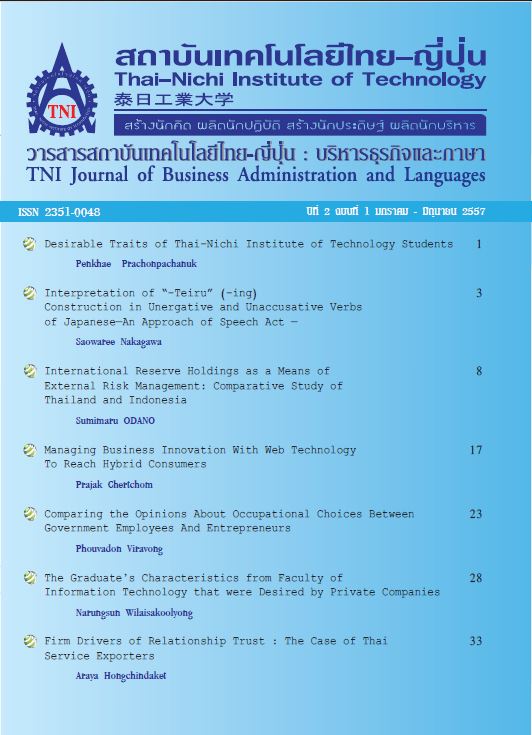The Determinant factors of Engineering Students towards the Significant of English Proficiency in the ASEAN Economic Community (AEC): A Case of 3rd year TNI Students.
Main Article Content
Abstract
The world economy has been in a wave of structural change due to the growth of international economic interdependence, especially in the notion of ASEAN Economic Community. According to the main goal of AEC, it is to seek regional economic integration by 2015 which includes various areas of cooperation.
Therefore, it might be said that the more liberalized labor market could provide more opportunities for Thai workers. However, it is indicated that Thai students need to improve their weak English proficiency for communicating with other people from other nations. This study, thus, aimed at finding factors affecting prospective Engineering students’ English capacity for AEC.
The purposes of this study were mainly focused on investigating the students’ English learning problems and finding out classroom interaction techniques to help students achieve in learning English in order to apply with the upcoming of AEC.
Research samples were 40 students from Faculty of Engineering: Automotive Engineering, Productive Engineering and Computer Engineering. Instrument used for gathering the data was in-dept interview which consisted of 10 open-ended questions.
The findings from the interview were categorized into 7 groups as follows:
1) Teachers were required to provide students an opportunity to practice four skills of communication (listening, speaking, reading and writing).
2) It was significance for the students to have a learning experience with new and interesting teaching-learning materials outside textbooks.
3) The students were able to speak with Thai and foreign teachers, but were not able to apply knowledge with real industrial placement.
4) The students commented that reading and writing were quite tedious. They needed activities that supported them to understand more than vocabulary and grammar memorization.
5) The students indicated that their English basic were not in tertiary level. The most important barrier was in areas of grammar, then, listening, speaking and reading respectively.
6) The students replied that they lacked confidence to speak English.
7) The students needed learning techniques that employed technology in classroom.
Further, the problems which barricaded the development of students’ English proficiency were demonstrated.
Article Details
Article Accepting Policy
The editorial board of Thai-Nichi Institute of Technology is pleased to receive articles from lecturers and experts in the fields of business administration, languages, engineering and technology written in Thai or English. The academic work submitted for publication must not be published in any other publication before and must not be under consideration of other journal submissions. Therefore, those interested in participating in the dissemination of work and knowledge can submit their article to the editorial board for further submission to the screening committee to consider publishing in the journal. The articles that can be published include solely research articles. Interested persons can prepare their articles by reviewing recommendations for article authors.
Copyright infringement is solely the responsibility of the author(s) of the article. Articles that have been published must be screened and reviewed for quality from qualified experts approved by the editorial board.
The text that appears within each article published in this research journal is a personal opinion of each author, nothing related to Thai-Nichi Institute of Technology, and other faculty members in the institution in any way. Responsibilities and accuracy for the content of each article are owned by each author. If there is any mistake, each author will be responsible for his/her own article(s).
The editorial board reserves the right not to bring any content, views or comments of articles in the Journal of Thai-Nichi Institute of Technology to publish before receiving permission from the authorized author(s) in writing. The published work is the copyright of the Journal of Thai-Nichi Institute of Technology.
References
Chiswick, B.R. and Miller, P.W. (2007). Modeling Immigrants’ Language Skills. Discussion Paper No. 2974, Institute for the Study of Labor, Bonn.
Nunan, D. (1991). “Methodlological in classroom research”. Studies in Second Language Acquisition, 13,2.
Pica, T. (1994). “Research on negotiation: What does it reveal about second-language learning conditions, processes, and outcomes?”. Language Learning, 44, 493-527
Harper, B., Squires, D., & McDougall, A. (2000). Constructivist simulations: A new design paradigm. Journal of Educational Multimedia and Hypermedia, 9(2), 115-130.
Beare, K. (2007). “Teaching Writing Skills”. Retrieved January 20, 2013 from https://esl.about.com/libraly/weekly/aa081701a.him
Ennis, R.H. (2003). “Critical thinking assessment”. Critical Thinking and Reasoning: Current Research, Theory, and Practice. Cresskill, NJ: Hampton.
Pathere, E. (2006). “Encouraging Peer Response”. Retrieved January 20, 2013 from https://www.teachingenglish.org.uk
Macrorie, K. (1980). Searching writing. New Jersey: Hayden.
Bailey, K.M. (1998). Learning about language assessment. Boston: Heinle & Heinle Publishers.
Lewis, J. (1990). Self-assessment in the classroom: A case study. In Geoff Brindley (ed.), The second language curriculum in action. Sydney: Macquarie University, National Centre for English Language Teaching and Research.
Hirschel, R., Yamamoto, C., & Lee, P. (2012). Video self-assessment for language learners. Studies in Self-Access Learning Journal, 3(3), 291-309.
Alexander, P.A. (2003). “The development of expertise: The journey from acclimation to proficiency”. Educational Researcher, 32(8), 10-14.
MacWhinney, B. (2005). “Extending the Competition Model”. International Journal of Bilingualism, 9, 69.
Stern, S. 1991. “An Integrated Approach to Literature in ESL / EFL” in Teaching English as a Second or Foreign Language. ed. Murcia, M. Boston: Heinle & Heinle Publishers
Krashen, S. (2004). The Power of Reading. Littleon: Libraries Unlimited.
Senior, R. (2005). “Authentic Responses to Authentic Materials in English”. Teaching Professional, 38, 71.
Egbert, J., & Hanson-Smith, E. (Eds.). (1999). CALL Environments: Research, Practice, and Critical Issues. Alexandria: TESOL.
Veeramani, D. and Russel, J.S. (2012). PREPARING THE AEC INDUSTRY FOR THE KNOWLEDGE ECONOMY. Accessed January 20, 2013, https://www.ce.berkeley.edu/~tommelein/CEMworkshop/Veeramani&Russell.pdf
Bean, J. (1998). Engaging Ideas. San Francisco: Jossey-Bass Publishers.


